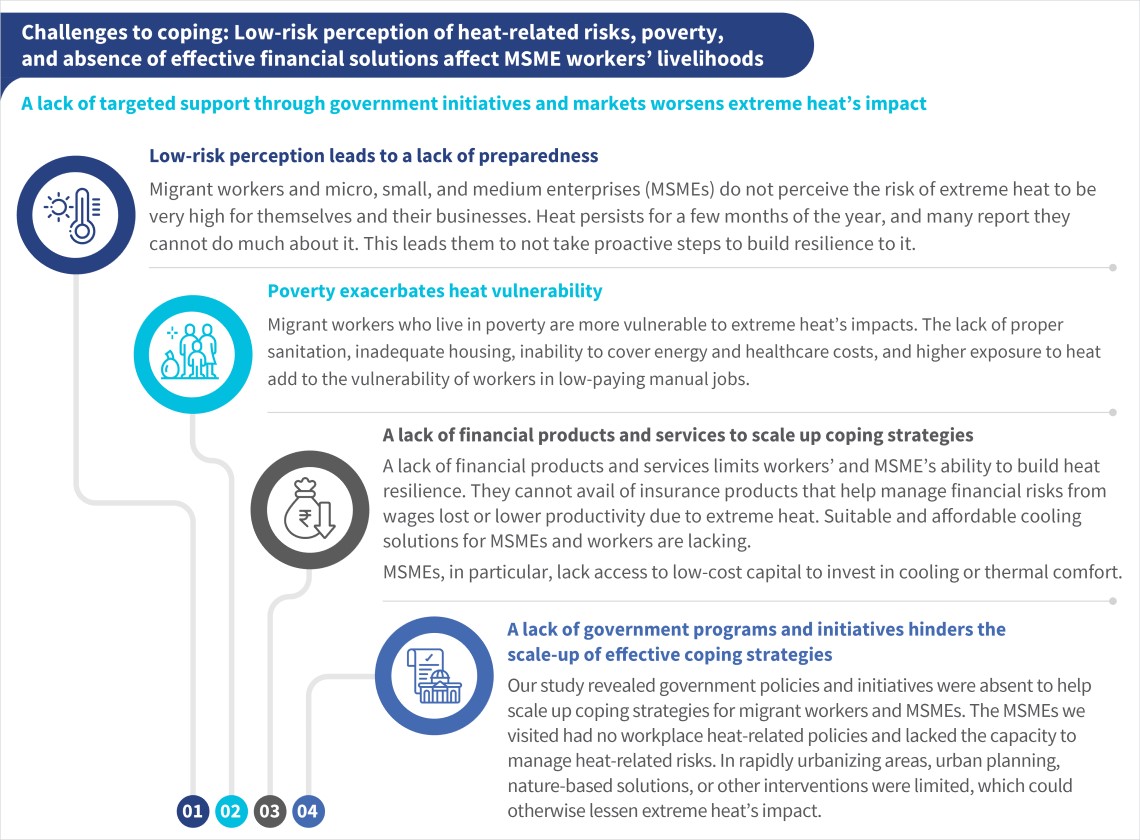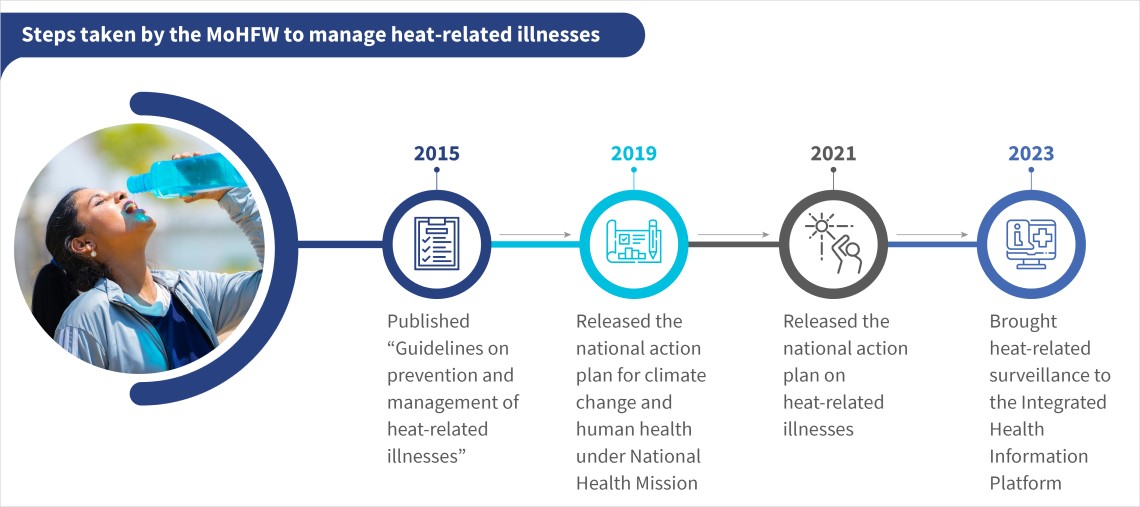The heat is on: Charting urban India’s course toward climate-resilient health
by Boijayanti Sarker and Puneet Khanduja
Jun 4, 2024
5 min
2024 has been a witness to record-breaking heat, with India and its health systems feeling the strain. Scientists have already predicted that by 2050, a staggering 300 million Indians will be affected by extreme heat. Heat strokes, dehydration, and degradation in quality of life due to increased heat in India are becoming the new norm. In our blog, we systematically explore the various facets of rising heat in urban India, its impact on our health, and what targeted solutions can comprehensively combat the myriad of issues stemming from the rising mercury.
The alarming upward curve of heat
In 2023, our planet sizzled through its hottest year on record, with global average temperatures near the critical 1.5°C threshold against the pre-industrial baseline. Extreme heat events have become increasingly commonplace as they wreck lives and kill thousands. Dishearteningly, climate experts have already predicted 1.6 million deaths and ~USD 7.1 trillion in economic losses by 2050 due to extreme heat.
India has also been battling recurring extreme heat events, especially in urban settlements, creating heat islands in a sea of already rising temperatures. Projections indicate that by the year 2050, 300 million Indians, and by 2100, 600 million Indians will have a severely diminished quality of life due to excessive heat. The implications are already dire: exacerbated health risks, strained healthcare systems, and an increased mortality rate that can no longer be ignored.
Understanding the heatwave hazard
The rise in temperatures is an emergent health crisis. Extreme heat events directly correlate with spikes in heatstroke, dehydration, chronic diseases, and diminished cognitive performance. Urban areas, in particular, face a compounded risk due to the urban heat island (UHI) effect, where Indian cities become significantly warmer than their rural counterparts.
In a focused study, MSC uncovered the ground-level impacts of extreme heat on seven informal settlements and MSMEs in Delhi NCR. We identified four major challenges to cope with extreme heat.
The study strongly corroborated the World Health Organization’s (WHO) findings of severe heat-related symptoms—from debilitating cramps to life-threatening strokes. This is especially true, as humidity makes it nearly impossible for people to cool down. We also observed that gender inequalities became worse as they disproportionately affected women from low-income households. It led to a greater burden of work and adverse pregnancy outcomes, such as stillbirth.
The study also exposed the immense strain on our health systems due to heat. It leads to widespread emergencies, disrupts health services, swamps hospitals, and stretches medical professionals to their limits. This is not just uncomfortable—it is dangerous as it leads to a cascade of crises that affect the most vulnerable.
The Indian government’s role: From recognition to action
Over the past decade, India’s strategy against heat waves has evolved significantly. Sparked by a catastrophic heat wave in 2010 in Ahmedabad, which saw temperatures soar to 46.8°C and claimed more than 1,300 lives, India initiated its first heat action plan (HAP). This groundbreaking plan laid the foundation for early warnings, community engagement, and exposure reduction tactics. The National Disaster Management Authority (NDMA) subsequently set forth comprehensive guidelines to encourage all heat wave-prone regions to adopt similar plans with a focus on early warnings, healthcare education, public awareness, and community partnerships.
Today, with HAPs active in 23 states and over 130 cities, India’s approach has become more refined and data-driven. The NDMA has expanded its focus to include detailed heatwave research, vulnerability assessments, city-specific hazard mapping, widespread educational initiatives, and state support mechanisms.
Simultaneously, the Ministry of Health and Family Welfare has intensified its efforts to combat heat-related health impacts. It rolled out detailed guidelines and integrated heatwave, HRI (heat-related illnesses), and ARI (acute respiratory infections) data into the national Integrated Health Information Platform (IHIP) for more effective monitoring and response. However, data management at the local level, especially Urban Local Bodies, warrants improvement. Nevertheless, this shift toward a digital-first health surveillance system marks a significant advancement in how we track and address nationwide heatwave impacts.
Solutions to mitigate and adapt to heat-related illness
A heat-resilient health system is paramount to improve overall preparedness and response to heat-related challenges. We have identified six instrumental changes needed to adapt to and mitigate heat-related illnesses in urban India effectively.
- Elevation of heat waves and heat-related illnesses as a policy imperative
A fundamental shift in the perception of heat waves and heat-related illnesses is needed at the policy level. The recognition of heat waves as disasters under the Disaster Management Act will unlock critical resources and powers that facilitate a more robust and coordinated response. This reclassification is not just administrative but a declaration of intent to safeguard public health.
- Intersectoral convergence for strengthened response
The fight against urban heat is not one that the health sector can—or should—wage alone. An integrated approach that brings together ministries of health, urban development, energy, and disaster management is crucial. This convergence can occur through inter-ministerial monitoring, such as oversight committees and intersectoral task forces. The country can then streamline efforts, avoid duplication, and ensure a holistic response that addresses the root causes and consequences of heat stress.
- Heat surveillance and prediction through the use of technology
As per the Global Commission on Adaptation, a warning before 24 hours of an impending hazardous event can cut the resulting damage by 30%, and an investment of USD 800 million on such early warning systems in developing countries can prevent losses of USD 3 to 16 billion per year. In the age of digital innovation, technologies offer unprecedented opportunities to monitor, predict, and respond to heat waves. Remote sensing, GIS, and AI-driven forecasting models can provide real-time data crucial for early warning systems. IoT sensors and mobile applications can revolutionize how individuals receive alerts, access information on cooling centers and heat wave safety measures, and lead to real-time patient tracing.
- Periodic heat vulnerability assessments to safeguard the most exposed
Per our study, we must refine our approach to understand heat risks to shield our cities’ most vulnerable population and tailor our systems to be gender-responsive. We can target our efforts more effectively if we institute biennial, in-depth evaluations that focus on the most perilous urban areas and communities.
Identifying hotspots and those at risk isn’t just about mapping temperatures—it’s about mapping needs. Despite existing climate assessments, zeroing in on the specific health threats can guide us to pinpoint and bolster our defenses where they are most needed. This ensures no one is left sweltering in the shadows.
- A national repository of knowledge and best practices
A national repository of heat action plans, research findings, and successful interventions can serve as a valuable resource for policymakers, researchers, and practitioners. This repository can help share strategies and improve the efficacy and reach of heat mitigation efforts. Knowledge is power, and it can be life-saving to manage heat waves.
- Engagement of local communities for locally led solutions
At the heart of any successful public health initiative is the community it serves. We can engage local populations, use the influence of resident opinion leaders, and foster grassroots movements to drive change more effectively than top-down mandates. Community-driven solutions, tailored to each locale’s unique needs and vulnerabilities, can enhance adaptation, preparedness, and resilience. See the whitepaper—“Enabling and financing locally-led adaptation”—to understand ways to engage local communities.
The way forward: A unified response to a shared challenge
The surge of severe heat waves across India’s metropolises is a glaring signal of the intertwined nature of global climate issues. A resilient urban future worldwide warrants a truly coordinated global response and seamlessly integrated local-level strategies for an enduring climate resilience framework.
We also need strategic investments in research to drive product and process innovation to bolster health systems. Such critical advancements must be championed through financial support mechanisms, underpinned by government commitment, and galvanizing the private sector to drive market-responsive solutions.
Crucially, discussions on heat waves should be a sustained fixture on the political stage to spur unwavering political will and facilitate rapid action. Sporadic reactions to heat episodes are a short-sighted fix. A robust, season-spanning strategy is needed to address and adapt to the escalating heat challenges fully.
Written by

Boijayanti Sarker
Assistant Manager
 by
by  Jun 4, 2024
Jun 4, 2024 5 min
5 min


Leave comments